A Failure To Communicate – Part Three
Thanks to Mike Gartland and John Morrow, The Kirby Effect is offering Mike’s “A Failure To Communicate” series from The Jack Kirby Collector. Captions on the illustrations are written by John Morrow. – Rand
Part Three was first published in TwoMorrows’ February 1999 Jack Kirby Collector 23.
In the last article in this series, we read how Galactus first appeared on the scene in Fantastic Four #48’s “The Coming Of Galactus!”, and that after he left he wasn’t supposed to return for a very long time. Perhaps this was why, at the end of that story, a reminder of the mysteries of the Universe was left behind: The Silver Surfer. To Jack this was just another plot thread, to be picked up and used for future stories and adventures; he had no idea at the time of the importance of what he had created. Stan Lee, however, found out soon enough through fan response; the Surfer was sensational.
The Surfer must rank among Kirby’s greatest creations; but believe it or not, Jack’s Surfer was short-lived, lasting about two-and a- half years. One must come to understand that there were actually two Surfers: The version Jack created and the one Lee “re-created.” Many are familiar with the often-repeated story of how Lee was presented with the penciled pages to FF#48 only to be surprised by the new character in the story. (Apparently when Jack discussed the plot with Stan he either neglected, or hadn’t yet thought of, the inclusion of the Surfer.) Roy Thomas was present when this occurred and it is he we have to thank for honestly relating a true story that Marvel historians can be sure of. Had Roy not been there and told the tale to readers, in my opinion the Surfer would have become yet another Kirby creation forever mired in the “co-created” ambiguousness associated with the “Lee/Kirby” creations.
Jack’s Surfer can only be seen in issues of Fantastic Four. We first become aware of the nature of the character in FF #49’s “If This Be Doomsday!”, of which we are again fortunate to have copies of the undiluted pencils. The Surfer is “alien” in every respect, except for the obvious (and understandable) fact that he speaks English. He knows and understands nothing of the Earth or humanity other than they are to be absorbed for Galactus. His credo is “energy is all”; mankind is merely Organic Energy to be converted— to be used constructively or destructively. This was the basis for Jack’s Surfer: A creature of pure energy, formed for exploration and war. According to the Conservation of Energy Law: “Energy can be converted (changed in form), but it cannot be created nor destroyed”; hence the Surfer was “formed,” not created by Galactus, as an extension of the giant, most likely.
“If This Be Doomsday!”
Pencil story art by Jack Kirby, dialogue/captions by Stan Lee, lettering art by Sam Rosen
First published in Marvel Comics’ Fantastic Four 49, April 1966
(Also featured in the previous article)
- page 1
- page 2
- page 3
- page 4
- page 5
- page 6
- page 7
- page 8
- page 9
- page 10
- page 11
- page 19
In FF#49 we see Jack’s Surfer in his original function, converting everything around him into energy; and as we can see from Jack’s liner notes, had Alicia not reached something inside him in time, she too would have been converted—a little something left out of the published story. It was Jack’s original intention for the Surfer to enter mankind as a blank slate, absorbing a new lesson about the human condition with every subsequent adventure. This becomes obvious from the early Fantastic Four/Surfer stories: In FF#49 and FF #50’s “The Startling Saga Of The Silver Surfer!”, he learns that life (any life) is precious. In FF #55’s “When Strikes The Silver Surfer!”, he learns about human emotions (through the Thing’s jealousy). In #57-61, he experiences human treachery. Each of these stories is a learning experience for the Surfer, and a reflection on us.
Of course, Stan was on these stories with Jack, with much enthusiasm I might add. We see, according to the Nat Freedland article reprinted in The Jack Kirby Collector #18, that Stan was already working out future Surfer-related plots with Jack while the artwork to FF#50 was still on the board, unpublished. Those plotting sessions became the basis for the story in FF#55 and somewhat touching on #57’s “Enter, Doctor Doom!”. Stan was enchanted with the character; he saw that fan response was so great that the Surfer had the potential to be a moneymaker for Marvel. Stan very much wanted to put out a book on the Surfer, especially while the character was hot. Unfortunately, due to publishing limitations put upon Marvel at the time, there was no room on the schedule; a book would have to wait, for now.
The stories between FF#48 and FF #61’s “Where Stalks The Sandman?” are peppered with either Surfer stories or cameos. It is with the Surfer’s return in FF#55 that Lee begins to have the Surfer espouse his philosophy to the masses. Using timeworn literary and Biblical cliches, the character becomes the comic book version of Billy Graham. Lee realized early on that fans reacted positively to the purity of the character; this made him a conduit to the young adult, college-age audience that was a vital part of Marvel’s readership at that time. It was also Kirby’s rendering of the Surfer as a noble majestic being that helps bring this dialogue off.
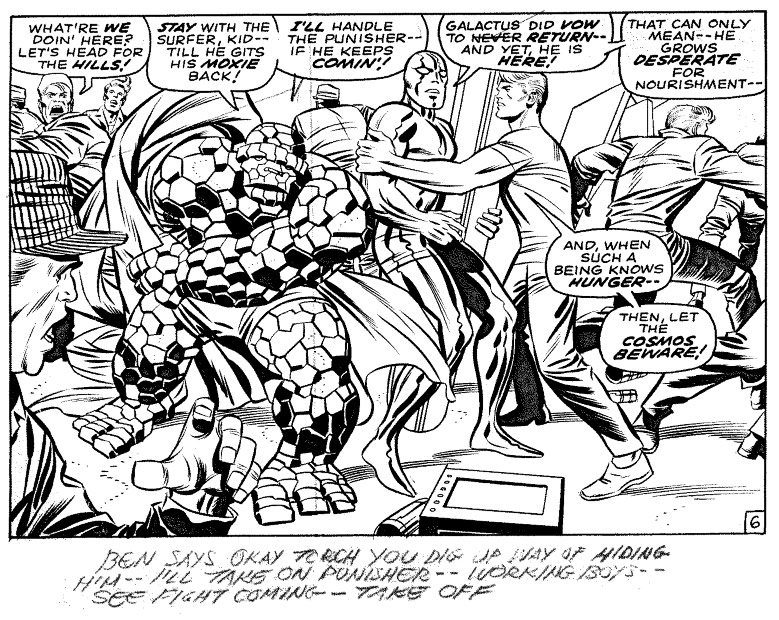
Fantastic Four #74, page 6. Kirby had the Torch hide the Surfer from Galactus.
In the published book, no mention of it.
After experiencing a plethora of human emotions and states, by FF#61 —approximately a year after his first appearance—the Surfer turns his back on mankind; and Kirby, ever progressive, turns his back on the Surfer temporarily, while pursuing yet newer creations and adventures. Stan, through the fans, never gets too far away from the character and sees to it that the fans are kept satisfied with Surfer appearances, while at the same time being careful not to overexpose the character. Of course during this time fans just couldn’t get enough anyway. Approximately three months after FF#61 the Surfer makes his first appearance in a non-FF book. Stan writes him into a Hulk story in Tales to Astonish #92-93, drawn by Marie Severin. A few months after that, the Surfer gets his first solo story, “The Peerless Power Of The Silver Surfer”, in the pages of FF Annual #5 in, perhaps, a testing of the waters towards a possible series. Stan was growing impatient about getting the Surfer his own book.
By the time the Surfer reappears in FF #72’s “Where Soars The Silver Surfer”, new avenues have opened up at Marvel. The company was changing hands and distribution was finally expanding. The characters who shared the Tales of Suspense, Tales to Astonish, and Strange Tales comics were being given their own books and new titles were finally being discussed for launching—the Surfer book probably among them. Jack wanted to be a part of the Surfer series; it must have stunned him to discover that the Surfer book was already being produced, with Stan writing the origin story and John Buscema as the series’ artist. Needless to say Jack was hurt; it wasn’t the first time and unfortunately, it wouldn’t be the last. Jack was preparing to put the Surfer’s origin down himself, and the stories beginning with FF#72 probably would have led into it; now it would be lost to us forever.
Some conjecture that Stan may have been keeping Jack off the book so he would have free rein to plot and write the character as he saw fit. A more practical reason may have been that, at the time, Jack was plotting and drawing three full books already: Fantastic Four, Thor, and the newly-expanded Captain America. There was also an Inhumans book that Stan wanted produced, and since Stan obviously enjoyed writing the Surfer more, would’ve deferred the plotting of that book to Kirby. (Jack apparently had been penciled-in for a planned Inhumans book, which was teased to readers in a Bullpen page. One interesting question is whether, when Jack did the Inhumans stories that appear in the back of the Thor books, or for Amazing Adventures, were those pages planned for the new book?) In any event, Jack was annoyed; but with new bosses in the company.—and Jack, ever mindful of supporting his family—he didn’t rock the boat. In what was probably doubly disheartening, Stan apparently asked Jack to do the Surfer story that runs through FF #74-77, helping to kick off the new series. With two exceptions, after FF #77’s “Shall Earth Endure?”, Jack— for whatever reason—doesn’t draw the Surfer anywhere, anymore.
Stan’s take on the Surfer’s origins are almost directly opposite of what Jack had intended. Jack had the Surfer as an alien who progressively learns to become human; Stan turns the story on its ear and has the Surfer as a human who becomes an alien. True, Stan’s origin depicts the Surfer as a being from another planet, but the character is human in every other respect. In writing his origin, Stan throws away all the alien aspects of the character that initially made him so appealing to readers; in fact, as early as “When Strikes The Silver Surfer!”, Stan, through dialogue, represents the Surfer as a being with a silvery coating protecting his body, thereby implying that he initially may not have always been as he appears. Upon learning about Lee’s origin for the Surfer, Jack disavowed any relation to the character. That wasn’t his Surfer, as far as he was concerned.

FF #76, page 14. Kirby takes time to explain that Reed will section off the cabin of their craft so Ben can exit; Lee omits any reference to it.
The Silver Surfer book was successful, but not for very long; after the first issue or two sales began to drop. It appears that the stories were originally intended to be standard 20-page editions, but with Martin Goodman wanting to fill the racks with books of varying price points, the comic became a 25¢ forty-pager (the company was also experimenting with a black-&-white Spider-Man magazine-size comic at the time as well). This meant not only that a book was twice the price of a regular comic, but that standard stories had to be stretched out to twice as many pages, and still hold the readers’ interest. Lee’s writing was well over-the-top dramatically on this book—so much so that many readers were turned off. In making the character human, he became just another angst-ridden Lee super-hero. Although his message was sincere, readers didn’t care to see this once-noble character on his knees with his hands raised in supplication, crying and bemoaning his fate and man’s inhumanity to man in every issue. Lee took his inspired messages from the Surfer/Fantastic Four stories and beat them to death in the Surfer book.
After several issues things were looking bleak for the Surfer mag. According to John Buscema in an interview in The Jack Kirby Collector #18, Stan told him he didn’t know what to do with the book anymore; he had lost the direction of the character. The direction of the Surfer always had been with his creator, Jack Kirby, and Stan would now call upon him to help fix this situation. It is evident from this example that, although the Kirby/Lee books were a collaborative effort, it was Kirby who was the driving force behind the team. Without Kirby, the books he and Lee pioneered were mediocre at best. It is also interesting to note that, after Kirby left Marvel, Lee lasted for about two years on the Lee/Kirby books—about the same time it took him to run out of ideas on the Surfer mag.
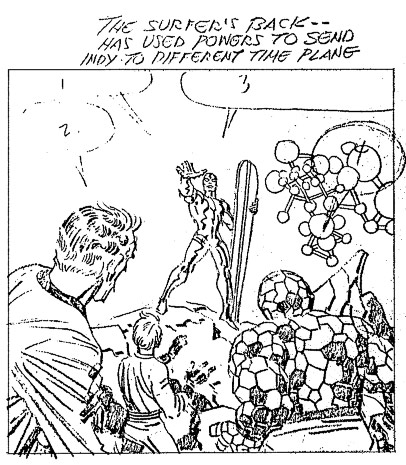
FF #76, page 20. Kirby’s notes show he used the Surfer to get rid of the Indestructible, but Lee ignores this, and there is no explanation in the published book of why the Indestructible disappears.
It was decided Herb Trimpe would draw the book, after inking a lead-in story penciled by Jack. This is why the last issue (#18) sports a cover by Trimpe and not Kirby; one would think a Kirby cover would’ve attracted more readers. (The book was to be retitled The Savage Silver Surfer with #19; for the record, the decision to terminate before the Trimpe stories appeared was based on earlier sales, not on Jack’s one issue.) The fact was that Jack didn’t want to have anything to do with the book. It was ironically insulting and irritating to him to be called upon to help save the Surfer at this time. Jack knew he would be leaving Marvel soon and that this story would probably be one of his last. The last two pages of the story may, therefore, be very prophetic. The Surfer was fed up with man and Jack was fed up with Marvel; before he left his creation, they both shared a catharsis. With this issue, the Surfer was left alone; Stan refused to let anyone else use the character for a long time. Others would eventually write the Surfer into guest appearances in various books, but there would be no more Surfer stories, no more inspiration. The Surfer would remain in creative limbo while his “soul” was working at another company.
By 1978, Jack was back at Marvel, finishing up an unpleasant stay. Unlike the Sixties, this time it only took Jack two years to get fed up. To complete his contract with Marvel, he was required to submit a certain amount of pages in a given time frame, and he wanted to complete that as quickly as possible. Once again the Surfer helps his father out. Marvel was touting the character as a saleable commodity to the media. Hollywood responded and a movie project was announced. An offer was made to Jack and Stan to re-unite on a Surfer story. Jack decided to do the book because it was assured to him that the story he and Lee came up with would be copyrighted as theirs alone. Also Jack wanted to make sure his name stayed with his character and did not become “lost” (like it did when a movie poster featuring Captain America listed Lee as creator of the character). It also helped him meet his contractual obligations with Marvel, page-wise. If the book was successful, a possible adaptation of the story to the big screen might be considered; all of this really boiled down to Jack, once again, trying to earn the most he could for his family.
Since the book was considered as a possible vehicle for the movie, the story was kept apart from the general continuity of the comics, with no references to other Surfer-related stories or characters. Jack submitted a fully-typewritten plot along with his pencils for Stan to dialogue. Stan wanted changes made and Jack balked, but as usual, grudgingly gave in. This is why the story reads unevenly and loses impact. This was the last time Kirby would work with Lee in comics; one need not wonder why.
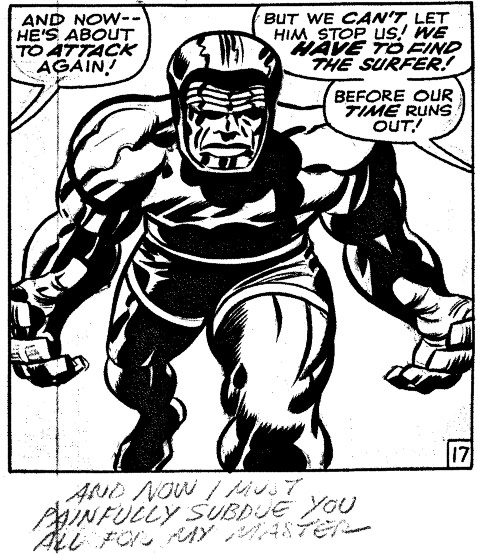
Throughout FF #76, Kirby’s notes show he fully intended the Indestructible to speak. It seems strange that the usually verbose Lee purposely rendered this character mute.
Jack once said in a published interview about why he stopped creating for Marvel: “When I would create something (ie. A character), they would take it away from me and I would lose all association with it.” It is ironic that of all the creations attributed to the Kirby/Lee team, the Silver Surfer—the one character universally acknowledged as Jack’s creation—would be so dominated and changed by Lee into a character no longer acknowledged by his creator. Time would be kinder to Jack’s Surfer in the pages of Fantastic Four than to Lee’s Surfer in the failed first series. Two men with distinctly different versions of the same character end up creating two characters. With no malice on either side, and good intentions gone awry, the Silver Surfer turns out to be the prime example of a failure to communicate.
(Special thanks to Mark Evanier for providing background information for this article.)


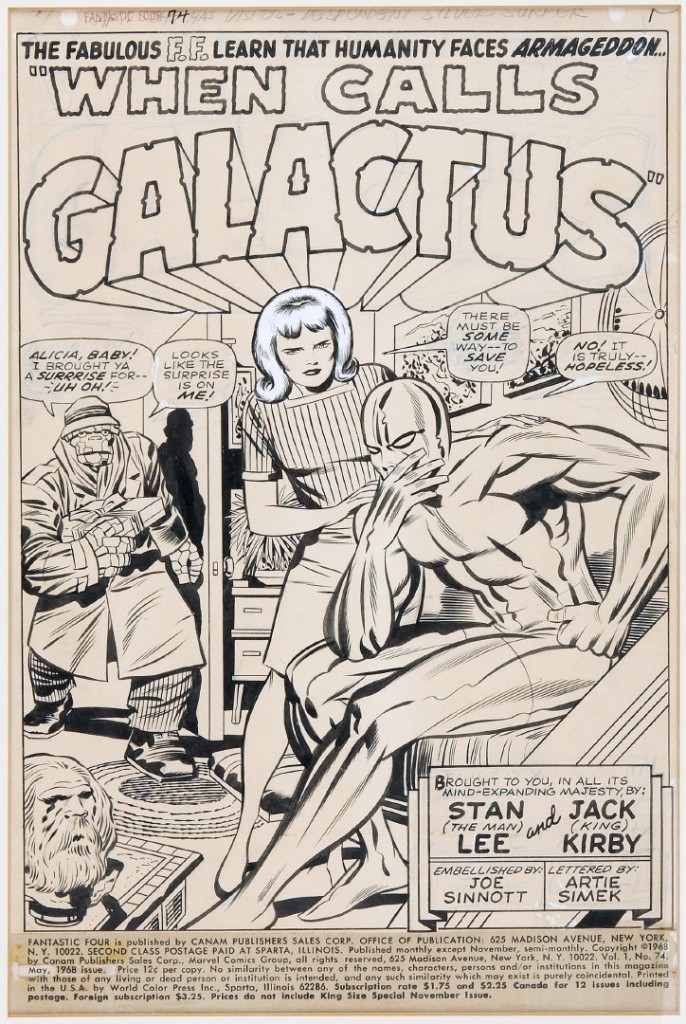

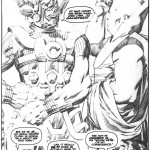

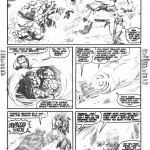
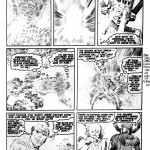
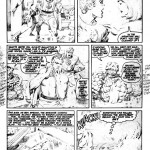
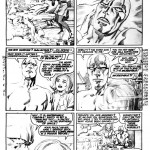
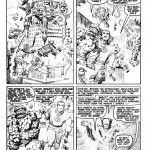
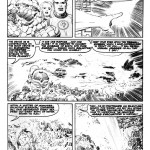


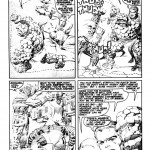

Mike, I notice you mention Roy Thomas was the first person to mention Lee was unaware of The Surfer until he saw Kirby’s penciled pages. I had thought the first mention was in Lee’s interview with Ted White, but as Roy’s comments predate Stan’s that may explain why The Surfer remains the only Marvel character Lee credits Kirby with bringing to him.
I remember reading that somewhere long before I wrote the piece; I can’t recall if it was from someone interviewing Thomas or a piece where Thomas mentioned it himself; but it’s out there somewhere!
-M-
Thanks Mike. Thinking about this a bit more it doesn’t matter which comments came first. Roy says he was present when Lee first saw the pages, and recalls his surprise. It isn’t something Stan told him about but something he witnessed.
It matters, Pat. Maybe not to you, and that’s ok.
If anyone has any ideas or pointers, please either post here or contact me privately.
Rand, Roy has told the story quite a few times. One example is right here:
http://www.twomorrows.com/kirby/articles/18thomas.html
“Stan would always talk about Jack as being this great artist, but he didn’t always play up Jack’s other contributions. Yet from the very beginning, he’s always been clear about the fact that Jack invented the Silver Surfer, and just tossed him into a story where Stan had not suggested any character like that. I know for a fact, having seen the pages in pencil when they came in, that the character was just called “The Surfer” in the border notes, not “The Silver Surfer.”
I was thinking maybe Roy had mentioned the story in an old interview prior to Lee’s interview with Ted White (1968 if I recall). Roy is clear though. He says he knows for a fact because he saw the pages when they came in.
BTW that same interview has a nice comment by Roy on Jack’s writing.
” Jack had certainly written a lot of great stories in his day; there was no doubt about Jack’s talent as a creator. He’d written stuff that back in the ’40s and ’50s was well above the level for the field. It didn’t seem to traffic quite as well in the ’60s. Certain aspects of it did. There’s a certain poetry about Jack, in concepts and phrasing. Other things could be a little bit clumsy, but you just take them all together, and they make a very interesting read, especially his Fourth World stuff at DC. I’d look at it, and I’d see these words in quotation marks, and weird things that bothered me, but at the same time there’s this kind of poetic feeling. He wasn’t the only person who’d go to the Bible and other places for inspiration. Stan did, I did, we all went to the classics for inspiration. But Jack was certainly one person who did that. He was a sensitive guy, a poetic guy, an intelligent guy; and that was bound to be reflected in the work.”
Thanks, Pat. That helps
Great series! thank you so much for this! However, I’m not sure Stan’s choices are always as odd as you make them out to be–not on the big picture stuff, but in smaller choices. I actually think Stan’s judgement is right-on often. I like the silent indestructible monster in that issue (would dialog have helped?); and I think the Thing calling something a “photon shield” doesn’t have the legs of “nutty forcefield.” I do agree that Jack’s Surfer is a more interesting concept than the one Stan made up…and that evidence supports that Jack’s concepts drove most of the memorable FF stories. But to me the pages you show are a collaboration that, in the short term at least, is working.
Just thought I should mention that all the captions accompanying the pictures in all my articles were written by John Morrow, not myself. They do not necessarily reflect my opinions, thanks!
-M-
I don’t know, “NUTTY OUTER SPACE FORCE FIELD” sounds awkward to me. Awkward and stilted in fact, but I suppose that is the primary allure of Lee’s weird frothy dialogue. Kirby note: “Punisher can’t take it—Is forced to use Cosmic Photon Shield,” is not suggested dialogue, but an expository caption suggestion.
Anyhow that is a very minor point. The most interesting thing is Lee has taken Kirby’s story and done a 180 degree turn on Kirby’s intent. It isn’t some mild tweak, it’s a Black and White turn around. The entire purpose of Kirby’s story has been thrown out.
Kirby: I went to the Bible. And I came up with Galactus. And there I was in front of this tremendous figure, who I knew very well, because I always felt him, and I certainly couldn’t treat him the same way that I would any ordinary mortal … and of course the Silver Surfer is the fallen angel. Galactus in actuality is a sort of god. He is beyond reproach, beyond anyone’s opinion.
To follow up on that anyone interested can search: http://en.wikipedia.org/wiki/Watcher_(angel)
“The the Books of Enoch refer to both good and bad Watchers, with a primary focus on the rebellious ones.”
It’s apparent from Kirby’s border notes ( His lost origin of Galactus in Thor) Kirby intended the Watcher and Galactus were of the same race, and knew one another.
“Fallen angel is a concept that is typically synonymous with a rebellious angel. Biblical commentators use this term as an adjective to describe the angels who are cast down to the Earth…”